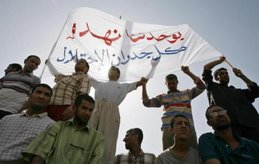Iraq's displaced people nightmare
Magdi Abdelhadi BBC Arab affairs analyst
Wednesday, 10 October 2007, 21:27 GMT 22:27 UK
The huge displacement of people inside Iraq appears to be contributing to the further fragmentation of the country.
The scale of the overall displacement is unprecedented in the modern history of the Middle East.
There are now an estimated four million Iraqis who have been forced to flee their homes, and the numbers continue to rise, according to the UN refugee agency.
Neighbouring Jordan and Syria, which have borne the brunt of the problem after receiving some two million refugees over the past few years, have now restricted access because they can no longer cope with the influx.
The plight of those who have fled their homes but have not been able to leave the country is dire, says the UN refugee agency.
The head of the Iraq Support Unit, Andrew Hamilton, told the BBC that an increasing number of provinces were turning the refugees away because they lacked resources to look after them.
He said with so many people in desperate need of shelter and food, Iraq was like a pressure-cooker.
Beyond Baghdad's control
Mr Harper said the UN agency had raised the issue with the central government in Baghdad, but was told that the local authorities had been urged to shelter the fleeing Iraqis.
This means that local governments are in effect ignoring directives from Baghdad.
Steve Simon of the US Council on Foreign Relations told the BBC: "Local authorities are taking ever greater unilateral prerogative in areas that they control because the central state is ineffective, it lacks capacity."
Mr Simon said the local governments were facing hard choices.
"They are not going to make their local constituencies unhappy by letting all these displaced persons from other areas in Iraq in to split a pie that is already pretty meagre," he said.
The refugee problem is also likely to make national reconciliation even more difficult to achieve.
'Recruiting-grounds'
Ghaith Abdul Ahad, an Iraqi journalist, says the areas where displaced Iraqis live have become fertile recruiting-grounds for militants.
"The insurgents in west Baghdad tell me that the hardest fighters are the Sunnis who have been kicked out of their homes by the Shia," Mr Abdul Ahad told the BBC.
There is a real fear that the temporary ramshackle refugee camps that today dot the Iraqi landscape are festering wounds that may take years to heal.
More ominously, they are a breeding ground for violence as well as social and political turmoil.
Outside Iraq, the long-term effect of the exodus is difficult to foresee.
Some analysts have drawn comparisons with the plight of the Palestinians, who were forced to flee after the creation of the state of Israel in 1948.
And if that analogy is anything to go by, then the Iraqi refugee crisis could become a destabilising factor for the entire region for years to come.
No one can predict the exact impact on the precarious demographic balance in neighbouring Syria and Jordan, which have received the highest numbers of Iraqi refugees.
These societies may continue to cope with the problem, as long as there is the prospect that the refugees will one day be able to go back.
But if years go by without that happening, the threat of instability may haunt the region for the foreseeable future.
قالت الحكومة العراقية إنها تواجه مشكلة كبيرة في التعامل مع الزيادة المستمرة في أعداد النازحين العراقيين داخل حدود البلاد.
يأتي ذلك في أعقاب التحذير الذي أطلقته المفوضية العليا لشؤون اللاجئين التابعة للأمم المتحدة بأن النازحين العراقيين يواجهون مصاعب جمة، حتى في داخل بلادهم.
وقالت المنظمة الدولية إن أعدادا متزايدة من النازحين العراقيين داخل بلادهم يواجهون مصاعب في إيجاد أماكن يلجأون إليها بعد ارتفاع عدد المحافطات التي تعتذر عن استقبالهم وتوفير الاحتياجات لهم.
وقال اندرو هاربر مدير وحدة مساندة العراق في المفوضية العليا للاجئين،في مقابلة مع بي بي سي، ان مئات الآلاف من هؤلاء النازحين الفارين من العنف يواجهون صعوبات متزايدة لان 11 محافظة من بين 18 محافظة عراقية ترفض استقبالهم بسبب قلة الموارد الكافية لتقديم التعليم والمساعدات الغذائية للداخلين اليها.
إلا أن المتحدث باسم الحكومة العراقية قال إن ثلاث محافظات فقط وهي النجف وكربلاء والبصرة هي التي لا تسمح بدخول النازحين لعدم وجود الإمكانات المادية الكافية للتعامل معهم.
واضاف أن الأزمة ليست بالحدة التي اشارت اليها المفوضية الدولية.
وقد حذر هاربر من ان عدم وجود حل سريع لمشاكل النازحين العراقيين، الذين بلغ عددهم 2.2 مليون نازح داخل العراق "يهدد بتفجير الاوضاع في البلاد".
وقال هاربر لـ بي بي سي إن مشكلة النازحين تتفاقم بما يخلق مصاعب متزايدة للسلطات العراقية فقد تظافرت أسباب أخرى مع مشكلة العنف لتزيد من تعقيد الأزمة ومن بينها انتشار وباء الكوليرا ومشاكل اجتماعية وصحية أخرى.
وأضاف ان السلطات لا تملك الموارد التي تمكنها من معالجة الأزمة، مما حدا بـ 11 محافظة إلى منع دخول المهاجرين أو عدم توفير الطعام للأسر الوافدة والدراسة لأبنائها. برميل بارود
وقال هاربر انه ناقش المشكلة مع المسؤولين العراقيين في بغداد، وابلغوه بانهم طالبوا المحافظات العراقية بالا تغلق ابوابها في اوجه القادمين من محافظات اخرى.
الجهات التي نزح اليها العراقيون
سورية: 1,400,000
الأردن: 750,000
دول الخليج: 200,000
مصر: 100,000
ايران: 54,000
لبنان: 40,000
تركيا: 10,000
في داخل العراق: 2,250,000
المصدر: المفوضية العليا للاجئين التابعة للأمم المتحدة
وقال هاربر: "لقد أصبحنا الان أمام برميل للبارود قد ينفجر في أي لحظة خاصة وأنه لا نهاية تلوح في الأفق للوضع الحالي
وقال هاربر ان نزوح 4،4 مليون عراقي فرارا من العنف هو أكبر تحد يواجه المفوضية العليا للاجئين والمجتمع الدولي في الوقت الراهن.
وأضاف أن عدد النازحين يزيد بمعدل 100 ألف شخص شهريا.
ففي محافظة ديالى مثلا، يقول موظفو الاغاثة إنهم غير قادرين على الوصول إلى آلاف الأسر، بما فيها النازحة من مناطق سكناها بسبب سوء الوضع الأمني.
وتأتي تحذيرات هاربر في الوقت الذي قامت فيه دول مجاورة مثل سورية بفرض قيود على اللاجئين العراقيين بسبب عدم قدرتها على استيعاب الاعداد الكبيرة التي تتوجه اليها.









